Soviet's deadly flower
The 2S5 Giatsint-S (Russian: 2С5 "Гиацинт-С") name after the hyacinth flower, is a Soviet/Russian 152 mm (6-in) self-propelled gun simpified in some ways and capable of firing further than the older 2S1 Gvodzika or 2S3 Akatsiya, even nuclear projectiles. It entered service in 1978 and is still active today with the Russian Army and Navy (still 570 in inventory and 600+ storage) and a few with Ukraine, Finland (now removed/resold), Belarus, but also exported to Ethiopia and Eritrea. Unlike turrets SPGs, the crew (except the gunner) are deploys outside of the vehicle when in use. It saw action (and still is) in Afghanistan, Chechnya, Donbass and Ukraine as of today.
122mm G-20 howitzer and 2S3 Akatsiya carrier, 2S5 Giatsint-S and its towed equivalent, the 2A36 Giatsint-P (pinterest)
As for NATO, "2S5" is its GRAU designation. The name was given in Russia, as traditional self propelled artillery is named after flowers. It is a different weapon system as the 2S1 Gvodzika, 2S3 Akatsiya, 2S7 Peon or 2S4 Tyulpan, and in a sense a smaller version of the 2S7: The artillery piece and its mount (howitzer) is unprotected (not turret). It was not seen as a problem given its range. It was said capable of engaging targets at longer ranges and higher rate of fire than the 2S3 Akatsiya notably and has been delivered in significant numbers. Now they see a new intensive use in Ukraine today.
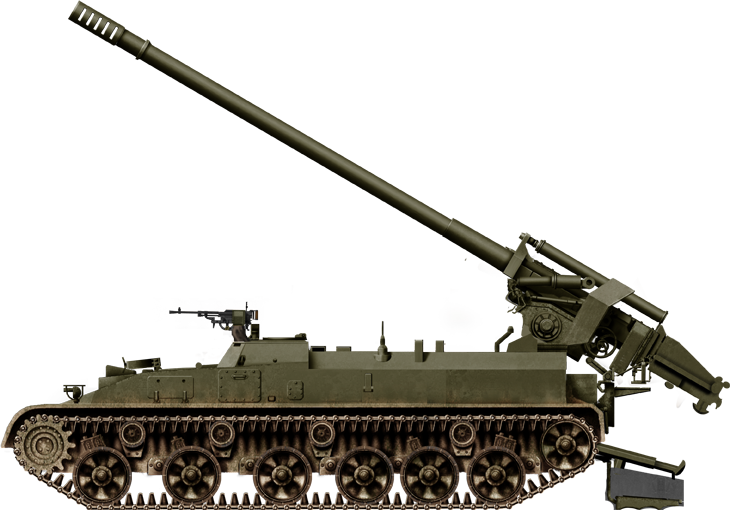
Intitial Development 1969-1969
With the resignation of the USSR premier Khrushchev after an almost ten-year break, work on left-propelled artillery resumed. Indeed Nikita Khrushchev has been a vocal opponent of artillery, preferring missiles for ground combat (but not only). With him out of the way, the Army obtained what it wanted since a while, modern seld-propelled artillery, which "consummables" were far more cheaper (and reliable) than missiles or rockets.First studied under the missile armament department of the 3rd Central Research Institute, and then newly recreated artillery armament unit, the new ordnance had its first draft. In 1965, Soviet Minister of Defense approved a program for the (re)development of classic artillery. They looked in particular as tthe newly introduced US M107 self-propelled howitzer, and first tests of the M109. Results from the use of Soviet-provided M-46 guns during an artillery duel between China and Taiwan showed insufficient range of Soviet artillery. There was a clear need to develop a new system mostly to outrange the competition. In 1968-1969, the 3rd Central Research Institute and defense industry enterprises carried out a long term project development of several new self-propelled artillery systems until 1980. Based on this on June 8, 1970, a resolution of the Central Committee and Council of Ministers (decree No. 427-151) ordered the development of a new 152 mm (6 inches) howitzer, both in towed and self-propelled version.
By November 27, 1968 already, the Ministry of Defense approved (order N°592) the start of research work to replaced the towed M-46 gun. Three variants were developed:
-The first was an open installation of the ordnance
-The second had an half protected installation of the gun
-The third was a fully enclosed installation in turret.
In September 1969, preliminary design features were reviewed by a commission of the Ministry of Defense. According to the first results it was found the best option was the open installation. Indeed the new gun ws bulky, too much to be encased in a turret. This formed the basis of the R&D project "Hyacinth-S" (GRAU index 2C5). It was supposed to be organically delivered to artillery regiments and brigades to replace the towed 130-mm guns M-46 and 152-mm guns M-47. Having a self-propelled artillery system would allow a much quicker startup for firing, and allow to retire before a counter-battery fire.
1970-78 development work
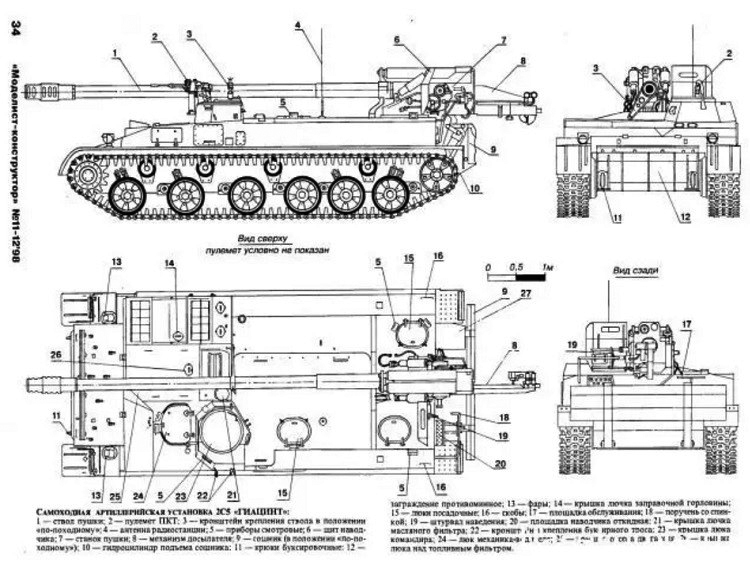
The Ural Transport Engineering Plant became lead developer for the 2S5 overall vehicle project, while the specific 2A37 gun was designed at the Special Design Bureau of the Perm Machine-Building Plant V. I. Lenin, in collaboration with Moscow's Scientific Research Machine-Building Institute for the ammunition. By the spring of 1971, two mounts were ready to test the new barrel of 7,200 mm manufactured at Perm, to start testing the gun ammunition. The late delivery of cartridge cases delayed these to September 1971 and until March 1972.
Tests showed that the shells when using a full charge of 18.4 kg, had an initial muzzle velocity of 945 m/s for a range of 28.5 km. On a reinforced charge (21.8 kg) it reached 31.5 km at 975 m/s. But the backdrop was a strong muzzle wave schock. To eliminate the problem, the powder charge was reduced to 20.7 kg, whole a redesigned smooth nozzle was introduced at the end of the gun barrel. In April 1972, the design was finalized and by the end of the year, two prototypes of the 2A37 gun were sent to the Ural Transport Engineering Plant to marry them to a self-propelled chassis. Prototypes of the 2S5 vehicle were sent first to the factory, and then underwent field tests. By 1974, the full test cycle was completed, after which preparations for mass production started.
At the same time, on the basis of 2S5, another version was developed as 2S11 "Hyacinth-SK". The difference was the cap loading method to eliminated brass cases from the ammunition and reduce costs. The scientific and technical groundwork served to create the 2S1 Gvozdika and 2S3 Akatsia and the separate-sleeve loading was accepted for production. On January 20, 1975, by decree of the Central Committee and the Council of Ministers (decree No. 68-25) the 2S5 Giacint-S self-propelled gun was adopted by the Soviet Army.

Object 307 tested in the winter of 1971.
Production
The first pilot batch of 2S5 was manufactured in 1976. In 1977 full-scale serial production was started at the Ural Transport Engineering Plant. The Perm plant was engaged in manufacturing the 2A37 gun. Production of the 2S5 continued until after the collapse of the Soviet Union in 1993, aft 17 years and circa 2000 vehicles. The vehicle was introduced in the Soviet Army in 1976 already for initial evaluation, and introduced in larger numbers from early 1978. Deliveries went on all along the 1980s and practically crawled to a standstill in 1990.Design of the 2S5

Rear side, photo from Vitaly Kuzmin.
Hull and general design
The self-propelled gun 2S5 is a turretless self-propeller artillery, meaning the gun, mount and its loading mechanism are in open air. It is using a modified tracked chassis already used by the Krug (SA-4 Ganef) surface-to-air missile system and shared with the 2S3 Akatsiya. They share most of their mechanical parts and the V-59 diesel rated for 520 hp.The carrier vehicle is built from welded from rolled steel armor (RHA) divided into three compartments:
-Engine compartment, with the main diesem and transmission forward,
-Control compartment (driver's station)
-Combat post, with the loading cradle.
In front of the hull, starboard side is located the engine compartment. To its left the driver's post is located, with all controls and dahsboard. His half-round hatch is opening back. He has two periscope to cover the front with the axial one swappable for an IR sight. Behind the driver's position is the commander's seat, in a superimposed position with small sight armoured windows, which also acts as the artillery chief when dismounted. It is provided a rotary rung mounted mount for a light defensive MG and joint IR projector.
The fighting compartment located in the middle and aft parts comprises respectively mechanized stowage to accommodate the ammunition load. On both sides along the sides are seats for the crew members, protected inside. On the starboard side in front is the operator's seat is the gunner's post with the operator's seat installed on the port side. Next comes four fuel tanks, a gun locker, feed trays and the hatch for supplying ammunition from the fighting compartment aft of the hull. Hingeg on the back plate is the aft spade and base plate to ground the vehicle when firing.
The artillery piece id placed at the extreme aft of the hull, placed on a rotative mount with a turntable for traverse while elevation is provided by hydraulic arms and dampers. This mount is also partly prtected with a shield, opened with a small window for the gunner's sight. The crew in operation comprises a section of seven men. 5 are carried in the vehicle, and two more in the accompanying ammunition carrier. Indeed the vehicle is nowhere near as large to contain enough ammunitions for prolongated fire.
The 2A37 gun has two positions, in march and combat. In stowed position, the spage aft is raised vertically, placed to rest on the back plate, and it is lowered in combat, thanks to an hydraulic system, firly resting on the ground. The gun is extracted from its travelling lock and raised, the folded loading apparatus extended, and the ammunition stacking provider also setup for an automated loading cycle. The loading mechanism is semi-automatic, with a chain conveyor and electric drive from the ammunition compartment. With the help of the loading mechanism, rounds are moved to the firing line. There os alsp a backup mode in case of jamming of the supplier from the ammunition rack, and ammunition could be stored and loaded from the ground. Whe preparing to fire, the gunner exit its travelling post and takes place aft left of the turntable, near the sights, protected by the shield. The vehicle is also given addition spade system forward for self-digging.

Protection, passive and active
The vehicle is lightly armored, to resist 14 mm rounds and protect the crew all around from splinters and small arms fire, with the front plate being 30 mm thick. It is 15 mm all around (sides and back). The base vehicle has collective nuclear, biological, and chemical protection (NBC). It applies when the crew is seated inside the vehicle during transport. However no all the crew is carried inside. Plus the vehicle is not equipped with smoke discharger not has any first warning system.Powerplant & Performances
The forward V-59 diesel engine is rated to 388 kW (520 hp). Suspensions are using torsion bar, with six cast and relatively small star-type doubled rubberized roadwheels on either side (tracks with double ends and central pin). The drive sprockets are located forward, and the idlers aft, using a modified unrubberized variant of the roadwheels. The tracks are returned by four return rollers on either side. Given the low but well suspended drive train, vibrations are kept to the minimum to spare the relatively delicate gun automated feeding loading system and sights. The roadwheels are more spread forward and close together aft to better support the main gun.The V-12 four-stroke V-59 diesel enginehad liquid coolingn, and inertial supercharging with a common output figure of 520 hp. In addition to diesel it could run on TS-1, T-1 and T-2 aviation kerosene. The transmission is mechanical and two-line with planetary rotation, six forward, two reverse gears. Maximum theoretical driving speed in sixth forward gear is 60 km/h and in second reverse gear 14 kph.
The 2S5 chassis resued all components of the SPTP SU-100P and thus suspensions comprised six pairs of rubber-coated road wheels, four pairs of support rollers. Rear idler, front sprocket. The track system comprises small links with rubber-metal hinges, 484 mm in width with a step of 125 mm. All axles had individual torsion bar but this is completed by hydraulic shock absorbers at the first and sixth road wheels only.
Operational range is on average 500 km (311 mi) with a top speed of 62 km/h (38 mph) on flat and down to 25 km/h (15 mph) off-road. It is capable climbing a Gradient of 60%, negociate a side slope of 30% and a vertical step of 0.7 mgap a trench of 3 m and ford 1 m of water without preparation. It is not amphibious. For tactical deployment it could fit inside the largest tactical transport of the USSR at the time. HD profile
Armament
152mm 3OF29 HE ammunition in an exhibition
The 2S5 Giatsint carried the 152 mm/L54 gun (54 caliber), fitted with a semi-automated load assisting system. It is not compatible with previous Soviet 152 mm artillery ammunition. The Giatsint-B and Giatsint-S ammunition was developed specifically in order to use the semi-automated loading system. The vehicle can fire the standard and rocket-assisted HE-FRAG shell, a HEAT shell to deal with armour formations, and smoke shells. Some sources reports cluster and smart anti-armor shells as well, even radio jamming ones developed once. Maximum range (HE-FRAG) is 28.4 km, and when rocket-assisted up to 30-33 km. Maximum rate of fire is 5-6 shells per minute but 1-2 shells per minute sustained. The mount is capable of a 30° traverse and a -2.5 to + 58° elevation.
A controversial ammunition also typical of the cold war was the low-yeld "special nuclear shell" rated for 0.1-2 kT, so small tactical yeld far from reach of its launcher. It was kept in high secrecy and only unveiled with the declassifications of 1990, with international ONGs being confirmed Russia had discarded its stocks. In normal conditions, these vehicles carries only 30 of the 60 shells nprmally deployed for a mission, the other half being carried by the escorting resupply truck (which also carries the missing two more loaders). The teams needs 3 minutes from full stop to starting firing. The vehicle was not completely unprotected from close-in attacks, having the commander's manned ringed 7.62 mm machine gun. There is even a shoulder-launched surface-to-air missile (MANPAD) carried inside to deal with helicopters or low-flying aircraft.

The 2A36 Giatsint-B gun, its towed version.
Other equipments
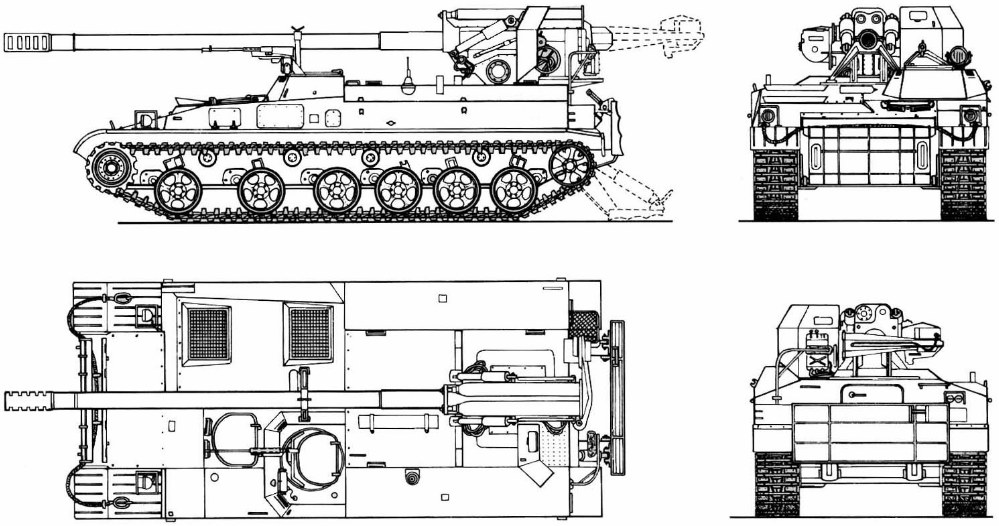
For aiming the gun and obervation day and night, firing the KPT machine gun there is a combined TKN-3A sight, with an OU-3GK searchlight installed in the commander's cupola. The gunner's position has a PG-1M panoramic artillery sight for firing from the interior. There is also the OP-4M-91A direct-fire sight. The driver's position is also served by two TNPO-160 prism surveillance devices and TVN-2BM night vision device. External radio communication comprised the R-123 radio station operating in VHF band to a distance of 28 km depending on the height of the antenna. Crew members communicated through the R-124 intercom.
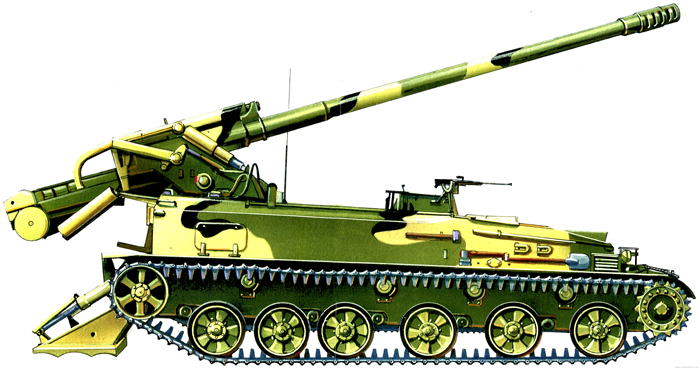
Profile drawing
2S5 specifications | |
| Dimensions (L-w-h) | 8.33 x 3.25 x 2.76 m (27.32 x 10.66 x 9 ft) |
| Total weight, battle ready | 28.2 tons (61,729 lbs) |
| Crew | 5 (section of 7 with 2 in ammunition carrier) |
| Propulsion | V-59 diesel 12-cyl. 388 kW (520 hp) |
| Top speed | 62 km/h (38 mph), 25 km/h (15 mph) offroad |
| Suspensions | 12x rdwls, 6x torsion bar, 4x Schock absorbers, 4x RR |
| Range | 500 km (311 mi) on flat |
| Armament | 152mm 2A37 L54 gun (30rds), 7.62 mm PKT |
| Armor | 15 mm (.59 in) +30mm fwd glacis addon |
| Production | Approx. 2,000 |
The 2S5 in action
The 2S5 self-propelled gun entered service with the artillery regiments and brigades of the combined arms armies of the USSR Ground Forces to replace the M-46 and M-47 guns. Each artillery brigade consisted of 5 battalions (4 self-propelled artillery and one reconnaissance), each artillery battalion consisted of three batteries. Artillery batteries consisted of six 2S5 self-propelled guns (a total of 18 guns in a division), however, in some divisions there were 4 batteries of six 152-mm guns or three eight-gun batteries (that is, 24 guns in a division). They served with the following before the fall of the USSR:308th self-propelled cannon artillery brigade GSVG (72), 13th Artillery Regiment (24), 111th Artillery Regiment (24), 178th artillery brigade (48), 211th Artillery Brigade (60), 231st Artillery Brigade (24), 235th Artillery Brigade (24), 303rd Guards Artillery Brigade (72), 385th Guards Artillery Brigade (72) and 387th Guards Artillery Brigade (72).
In Russia as of 2021, the 2S5 was stilled deployed in the following:
9th Guards Artillery Brigade (48) in 2000, 30th artillery brigade (c15) by 2015, 165th Artillery Brigade (c15) by 2016, 305th Artillery Brigade (18 in 2009), 385th Guards Artillery Brigade (65 in 2000), 39th separate motorized rifle brigade (36 in 2012), 7014th base for storage and repair of weapons and equipment, 36 in 2009, 7020th Harbin base for storage and repair of weapons and equipment, 54 by 2009, Perm PSH 52 in 2000 and Perm 39th arsenal 23 in 2000. In 2005-2006, the 385th Artillery Brigade was re-equipped with 2S19 "Msta-S".
The 2S5 self-propelled gun received its baptism of fire during the war in Afghanistan. Their fragmentation shells were useful to deal with enemy fortifications. They were aslo used as part of battalion tactical groups in the First Chechen campaign. It was also used in the Second Chechen War adn from 2014 deployed in the War in Donbas as well as used by both sides during the Russian invasion of Ukraine (2022). Website Oryx spioenkop states as of today (July 2023), 35 2S5 has been destroyed or captured on the Russian side, three of the Ukrainian side (1 destroyed, 2 captured).
Operators
USSR - Russia

Soviet Union used to have circa 2,000 in service before the production ceased. As of recently the Russian army declared having 950 units plus more than 850 estimated in storage. The Navy on its part has an organic park of 170 units (+an unknown numbers storage). The stock diminished as per the losses in Ukraine in 2022-2023. Before 1991, 500 were deployed in Eastern Europe.
Ukraine

One of the successors state, Ukraine was ordered by treaty to send back to Russian many vehicles in its park. Only 25 were kept as of September 17th 2022, or 18 for Russian sources, to which least six captured ones added up after the Russian Invasion of Ukraine.
Belarus

Belarus as a successor state was authorized to keep the bulk of its domestic units, thus 107 to 120 are estimated in service there. It is also alleged that other successors states as Georgia and Uzbekistan also possessed some, but it's not corroborated by all sources.
Ethiopia
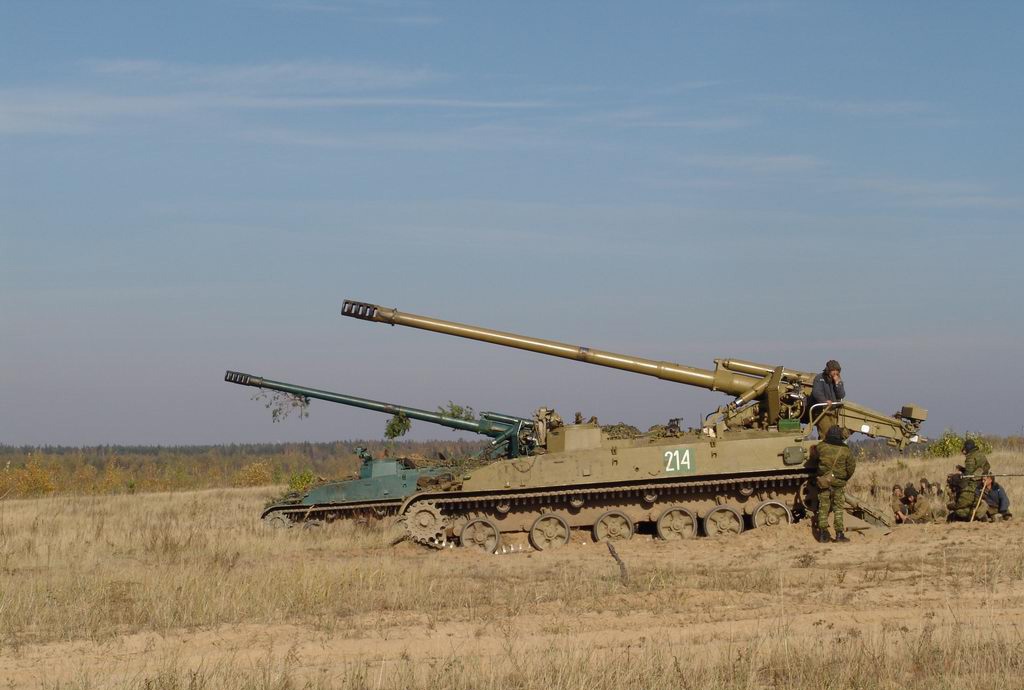
Photos of the Ethiopian model impossible to find. Livery likely like this one sand beige vehicle
The state of Ehtiopia acquired 80 second-hand Russian vehicles, which is the only contingent deployed in Africa. Its precise acquisition dates and use are not well documented, neither the Erithrean use (a dozen allegedly) as for 2021. Ten has been provided before 1990.
Finland
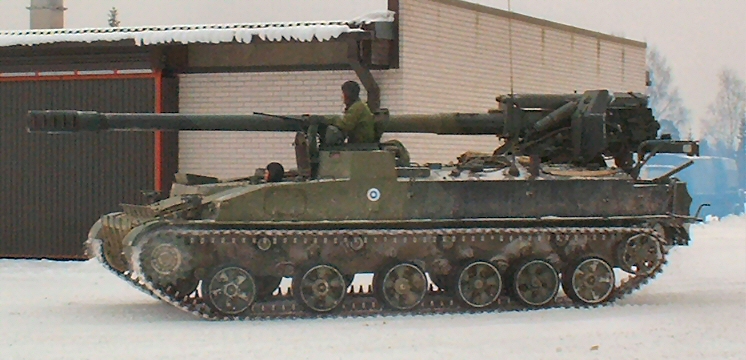
Known as 152 TELAK 91, 18 units were acquired after 1990, and modernized since. It is not expected that they will be used much longer after talsk of adhesion of Finland into NATO, since these are not compatible with NATO ammunitions and relies on a Russian-provided stock that is now unavailable. The number as been confirmed by 2021.
Improvements and succession

After mass production cased, modernized versions were developed under the classic designations 2S5M and 2S5M1:
The 2S5M had the new ASUNO 1V514-1 "Mechanizator-M" fire control system and upgraded load system to fire the 3OF60 HE-Frag (range 37 km) as well as 902V smoke grenade launchers
The 2S5M1 had a modification allowing to use the L15A1 shells (range 30 km) and ERFB BB shell (41 km) for export.
SP5: An experimental modification with a 2A86 gun instead of 2A37.
2S11 Giatsint-SK: Modification with the installation of a 152-mm 2A52 gun with a cap-loading method.
In 2004 R&D led to developed a new artillery system based on the 2S5 replacing the 152-mm 2A37 by a howitzer compatible with Koalytsa gun, mount and ammunitions for commonality. Nevertheless the officiel Russian succession for the 2S5 is the turreted 2S19 Msta-S. Gradual replacement is ongoing and will take until after the 2030s.
Sources
eragun.org.uaOn russiabeyond
weaponsystems.net
alchetron.com
armyrecognition.com/
On Wikipedia RU
The 2S5 on Wikipedia EN
2S5 on Mil-today.com
On armedconflicts.com
3D model on turbosquid
News
ukrainetoday.orgdefencetalk.com/
Latest updates on kaskus.co.id
2s5 at the battle of bakhmut
Illustration
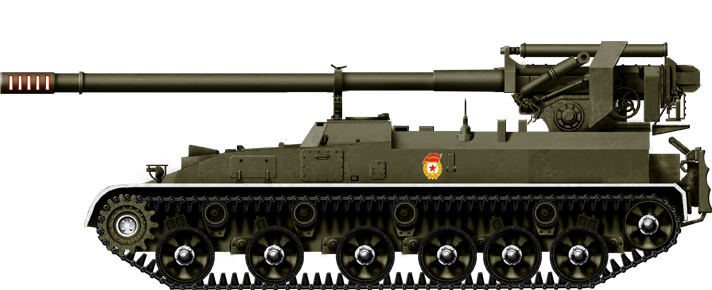
2S5 In parade, 1978
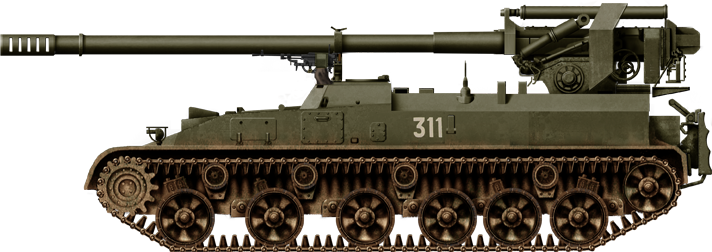
2S5 in service in an East Europe based unit, 1980s
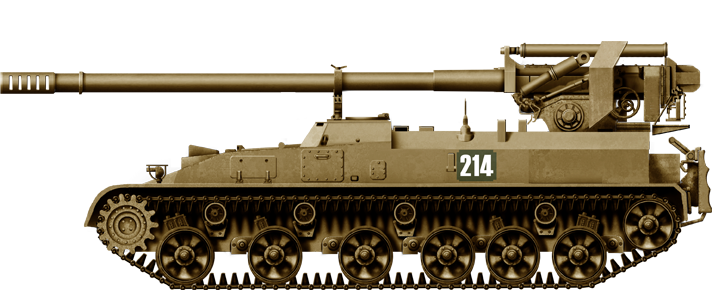
Vehicle in sand Beige livery, exercises, unknown unit or location
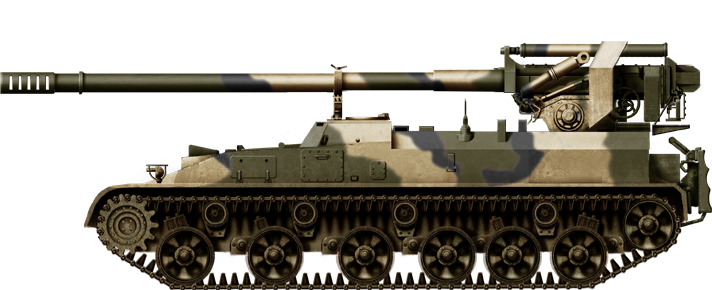
Camouflaged Russian 2S5 as of today
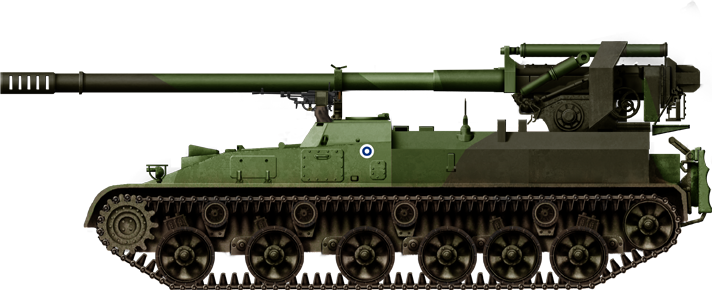
Finnish TELAK 91 as of today
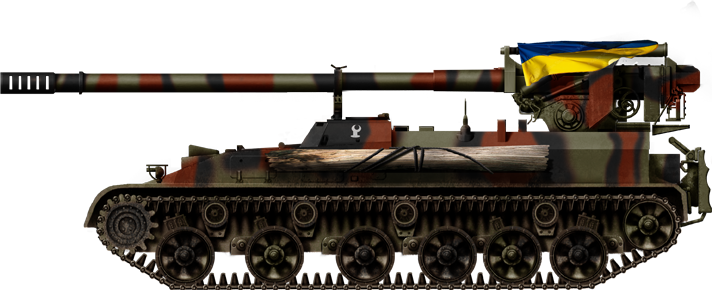
Ukrainian 2S5 in action, 2022.
Gallery
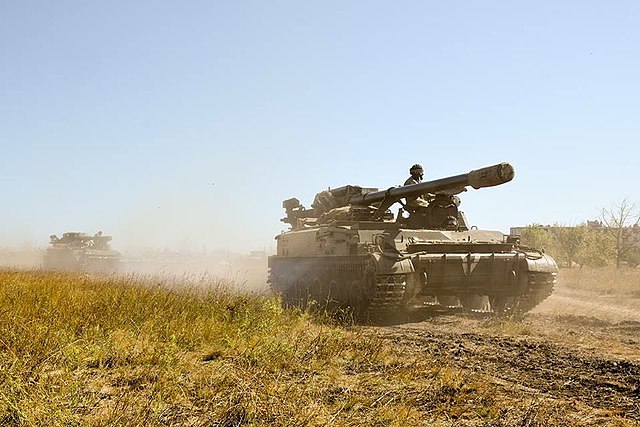
In manoeuvers

A modern Russian army camouflaged vehicle
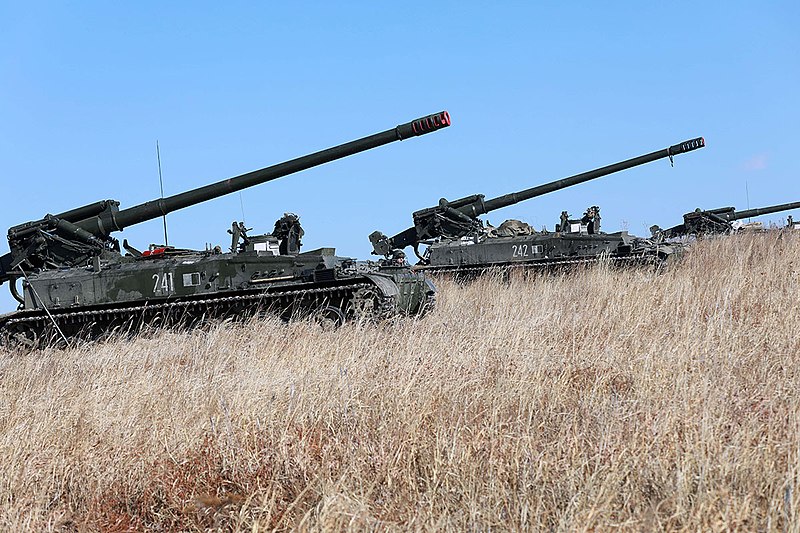
22S5 in an exercize in 2020
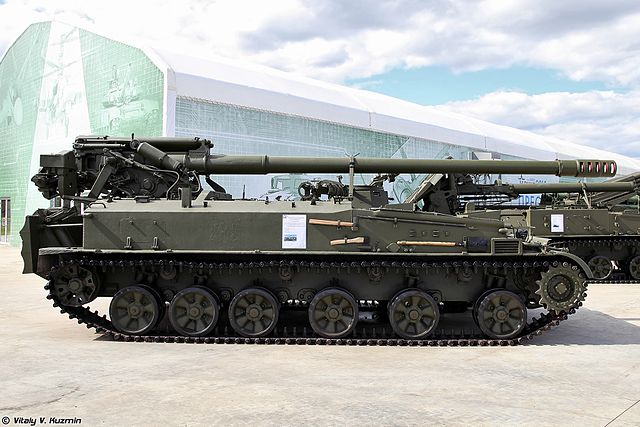
2S5 in Patriot Park near Moskow
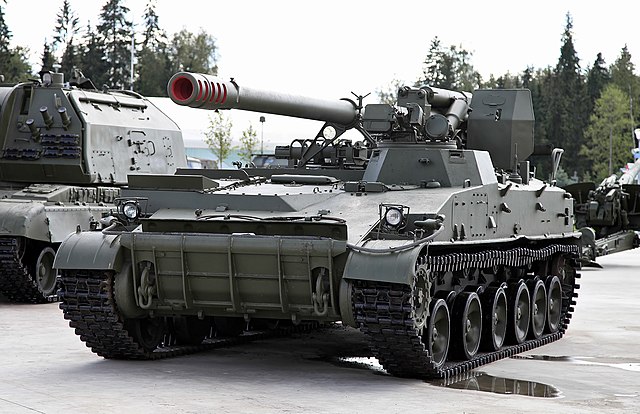
2S5 in Patriot Park near Moskow
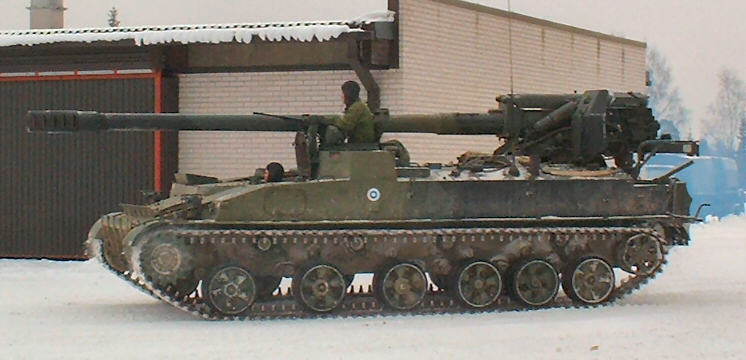
Finnish 152 TELAK 91











From pinterest
Videos

Cold War Tanks


































Cold war tanks posters

Cold War Main Battle Tanks

Cold War Soviet Army

